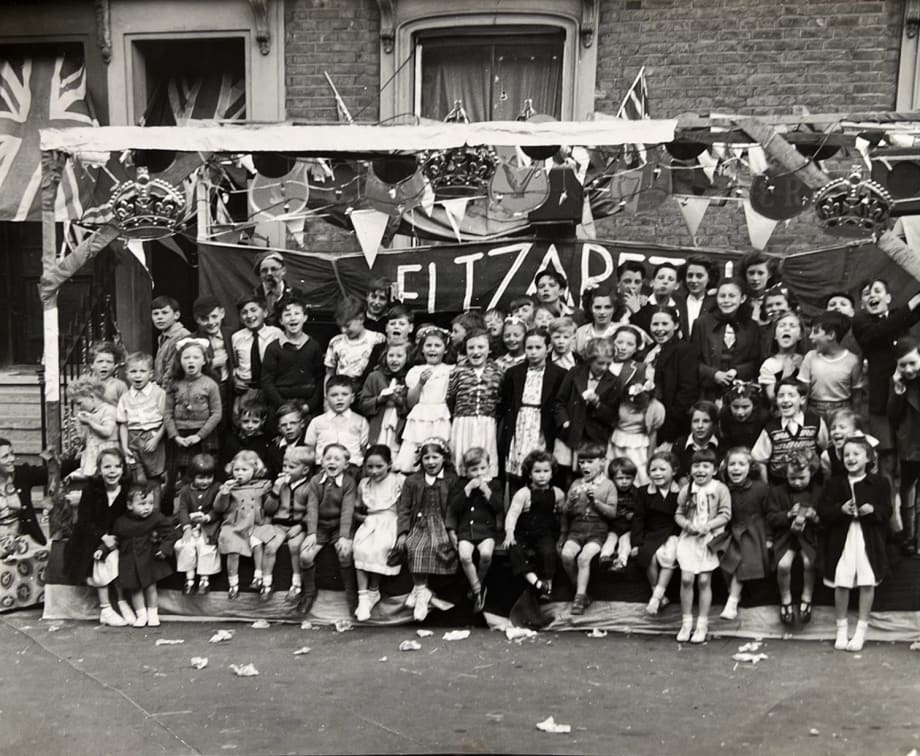James Hyman Gallery is pleased to present an online exhibition of early works by Nigel Henderson that depict street parties in East London at the time of the Coronation of Queen Elizabeth II in 1953.
Photographed near the Henderson's home in Chisenhale Road in Bethnal Green these rare photographs - most of which have never been exhibited before - focus on childhood celebrations and combine casual photographs with amazing group portraits.
After leaving the Slade School of Art Henderson began to experiment with photography, and for a short period between 1949 and 1952 he took numerous documentary photographs of Bethnal Green in east London, where he was then living. At that time photographs were not editioned and most of Henderson's negatives were never even printed. The rare vintage prints that do exist are usually single prints or are one of two or three known prints.
Known for his documentary and experimental photography and imaginative use of collage, Henderson was a founding member of the Independent Group in 1952, with which he regularly exhibited, notably in This Is Tomorrow at the Whitechapel Art Gallery (1956).
ABOUT NIGEL HENDERSON
The important art critic, David Sylvester, described Henderson as 'a seminal figure in post-war British art' and 'an artist who took photographs'.
Nigel Henderson was a major figure in the radicalisaton of post-war British art. Placing photography and collage at the centre of his work, he was a key part of the Independent Group along with friends such as Edouardo Paolozzi and William Turnbull. His work is comparatively rare as much of it is in museums, including Tate which holds a major archive of his photographs.
He studied biology at Chelsea Polytechnic in London and then worked as an assistant to Helmuth Ruhemann. In the later 1930s he produced paintings influenced by Yves Tanguy, as well as collages. After serving as a pilot for coastal command in World War II, he studied at the Slade School of Fine Art in London. There he befriended Eduardo Paolozzi, with whom he visited Paris, meeting Brancusi, Léger, Giacometti, Braque and Arp.
After leaving the Slade he began to experiment with photography, and between 1949 and 1952 he took numerous documentary photographs of Bethnal Green in east London, where he was then living. In other photographs of the period he achieved unusual effects by altering negatives or by placing objects directly on light-sensitive paper to create photograms.
He was associated with the Independent Group on its foundation in 1952, and with Paolozzi and others he participated in the Parallel of Life and Art exhibition at the ICA in London in 1953 and also in the pioneering Pop art exhibition This Is Tomorrow at the Whitechapel Art Gallery in London in 1956. At the latter he showed the large and disturbing altered photograph Head of a Man (1956; London, Tate).
After his first major one-man show at the ICA in 1961, Henderson began colouring some of his photographs with paint, as in Plant Tantrums (1961; London, Tate). From 1965 to 1968 and from 1972 to 1982 he ran the photography department at the Norwich School of Art while continuing his own photographic work. He often produced works in series that were connected by a particular striking image, as in the Face at the Window series which he worked on from 1977 into the 1980s. This centred on the image of a bandaged face, which Henderson had found on a cigarette card. It was followed in the 1980s by the two series Heads in Blocks and Single Heads , in which he made different versions of a self-portrait image.

